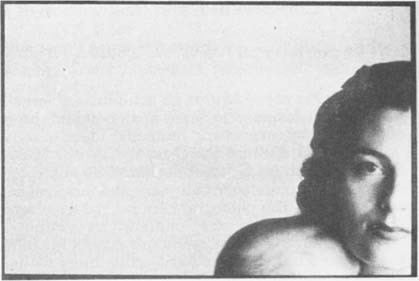
Topics in Photographic Preservation 1991, Volume 4, Article 13 (pp. 161-165)
The Family of Man is an exhibition of large-format black and white photographs designed to reach a wide public through the international language of photography, expressing humanist ideas of universal fraternity.
In 1955, Edward Steichen, then at the Museum of Modern Art in New York City, painstakingly selected five hundred and three images for the exhibition. The selection took place over two years and included some of the most beautiful images of the period. The photographers ranged from celebrated and established professionals to completely unknown amateurs.
The novelty of this ambitious project lay in part in the method of presenting the images. Large poster-sized prints hung without frames or glazing were used for the exhibition to establish a greater intimacy with the viewer.
In about 1970, the exhibition was personally donated by Steichen to the Grand Duke of Luxembourg. Though an American citizen, Steichen was born in Luxembourg. Today, The Family of Man represents one of the most important human events of the 1950's.
The prints in this exhibition had been regarded as documentary exhibition materials rather than valuable photographs. The gift was completely neglected for many years, until, through the intercession of M. Jean Back, it was transferred to the Centre National de Autovisuel in Dudelange, Luxembourg. Nearly all the 503 original images were in fragile condition, having endured numerous years of travel and exhibition, followed by storage under very poor conditions.
In its present condition, the problems encountered with The Family of Man are good examples of wear and tear caused almost entirely by excessive use. The project by Steichen to create an exhibition in which photography would have a central role was successful beyond all expectations. Following the popularity of the exhibition in New York City in 1955, the designers decided to approve numerous international venues. The Family of Man then started a long tour around the world, and was seen by some nine million people. Unfortunately, the photographs suffered from the successive shipping and exhibition.
The gelatin developing-out photographs are mounted overall to large masonite panels which provide a rigid support, but are heavy and bulky to transport. In addition, the larger images are mounted onto metal frames, attached to the verso of the masonite with screws. The gelatin emulsion, the most vulnerable component of the photograph, was exhibited without any protection in the form of glazing.
Most of the damage observed on the photographs could with all probability have been avoided, due as it was to the negligence of those who handled the panels. Insufficient care was taken in packing the photographs for transit. Some photographs were housed with the metal mount of one image abrading the image surface of the one behind. In some cases, a protruding screw in the back of one frame caused tears in the photograph it was placed against (Figure 1).

Figure 1
Another case of irresponsible handling was evident in the footprints on a couple of panels. Someone had walked on the photographs without paying attention to what they were wearing on their feet!
During transit and exhibition, various breaks had appeared in the panels. Someone then apparently made attempts to camoflage these damaged areas. These improvising repairmen seemed to have used the first thing that came to hand for their patching-up operations, without paying much attention to the quality of the materials they used. The variety of products found on the images suggests that the treatments were done in different locations and under different conditions.
Of the hastily applied repairs, the “inpainting” work was certainly the most disfiguring (Figure 2). Materials of all types were used, including Magic Marker, ink, and acrylic paint. The inpainting was done not only in neutral tones, but also in green and blue. The unfortunate characteristic that all these treatments have in common is their irreversibility.
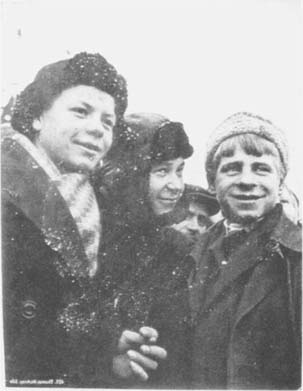
Figure 2
Some of the most damaged panels had been coated with a thick and glossy layer of varnish, completely inappropriate to the original matte image. The varnish, which in most cases was quite discolored, had formed little bubbles that were threatening to lift and detach the emulsion beneath. The varnish itself exhibited numerous scratches and areas of abrasion. In addition, dust and dirt embedded in the varnish disturbed the aesthetics of the image.
In addition to the damage caused by travel, exhibition and poorly executed treatments, one part of the exhibition also suffered from being stored for long periods under humid conditions prior to being transferred to the CNA. High humidity levels caused mold to form on numerous pieces. Luckily, these microörganisms only affected very small areas of the photographs in question.
The humid environment also caused portions of the masonite support panels to lift away from the metal frames used on the backs of the larger pieces as reinforcement. In some cases, the masonite pulled away with such force that the screws left gaping holes in the masonite where they had once served to secure the two supports together.
In ennumerating the many physical damages that The Family of Man exhibition sustained, it is reassuring to note the chemical stability of the images themselves, which survived well despite their tortured past. Almost no yellowing, discoloration, fading or staining of the silver image was observed. This fact is even more surprising when one realizes that the photographs were adhered overall to masonite boards. One should not forget that the panels not only traveled from one continent to the other, but that they were also exhibited for long periods. A contributing factor to the excellent image stability no doubt lies in the care taken in their original manufacture.
Because of the change in attitude toward the exhibition, which has grown from its role as a collection of images to a representation of our global cultural heritage, it was clear that The Family of Man would have to undergo careful and extensive conservation treatment. The project was complicated by the large dimensions of the images and their being mounted overall to rigid supports. Anne Cartier-Bresson helped to finalize treatment options with her valuable advice.
To begin with, there was uncertainty with regard to the quality of the supports. Masonite certainly is not the ideal support for the preservation of photographs. But, given the good condition of the images, it seemed extreme to remove the photographs from their panels. This decision was made not only due to the risk involved in such an unmounting operation, but also because the mounts are an integral part of the original work's presentation, and play an important role in the whole exhibition. It was therefore decided to only perform basic treatments, to include consolidation and removal of poorly-done previous treatments.
A large amount of surface dirt had accumulated on the panels during storage. This accumulation was reduced on the panels' versos with erasers. The image itself was carefully brushed with a soft Japanese brush to remove loose dirt. Solvents used locally, only in the cases of heavy stains and dripped-on accretions.
The varnished photographs presented the worst problems, especially where dirt was imbedded in the varnish. A very long and delicate solvent treatment was undertaken to remove discolored varnish layers (Figures 3 & 4, page 164).
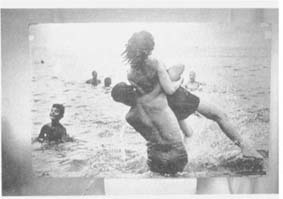
Figure 3
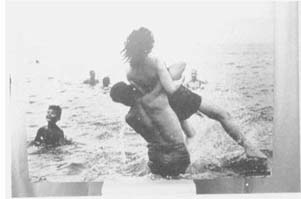
Figure 4
Additional treatment was primarily limited to consolidation of paper and emulsion layers. Tears and missing areas were more frequently encountered on the exposed areas of the edges and corners. Ninety percent of the prints were affected.
Fills and repairs were made using Japanese paper and methyl cellulose. In several images, areas of abrasion were found to be extremely deep; to the extent that they could be described as holes in a few cases. These were filled and consolidated with cellulose powder and methyl cellulose. The flexibility of this material enabled us to reconstruct missing areas, such as whole corners, through a molding process. The missing and reconstructed areas were integrated by retouching with watercolor (Figures 5 & 6).
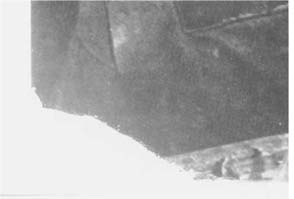
Figure 5
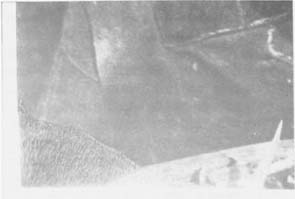
Figure 6
Inpainting presented another difficult problem. As was mentioned previously, most repainted areas were almost insoluble in most solvents that were safe to use with the photographs. Since no solvent proved to be successful, scalpels were used to mechanically remove over- and inpainted areas. Losses were inpainted with watercolor.
In the course of treatment the reinforcement system on the panel versos required repair (Figure 7, page 165). Some of these were no longer serving their original function of providing support and rigidity. The original system of mounting with screws was not appropriate for successfully joining the wood and metal components. Ideally, the use of adhesives was to be avoided in order to prevent future chemical degradation. Metal bands were therefore used to secure the panel and metal frame without imposing unnecessary stress (Figure 8). These also provided the option of future adaptations or changes. The dimensions of the metal bands are such that they do not interfere with the image.

Figure 7

Figure 8
After treatment, each panel was wrapped in paper in order to protect the image while waiting for final installation. The treated photographs of The Family of Man will be exhibited in the renovated galleries of the Château de Clervaux, where a permanent exhibition will be installed.
The project of the new exhibition of the collection, under the supervision of Georges Calteaux, director of the Service of National Monuments and Sites, will be executed with very strict environmental conditions in mind.
Only such scientifically controlled exhibition conditions will provide the panels with appropriate preservation while permitting the public to admire these beautiful photographs.